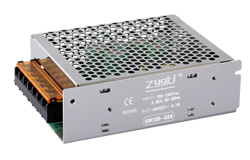Nachrichten
Bidirectional DC-DC Converter: Efficient Power Conversion in Both Directions
Autor: ZYG Leistungsmodul Time: 2023-7-1
Introduction
In recent years, there has been a significant increase in the demand for bidirectional power conversion systems. These systems allow power to flow in both directions, enabling efficient energy transfer between different sources and loads. One crucial component of such systems is the bidirectional DC-DC converter. This article will delve into the working principle and advantages of the bidirectional DC-DC converter, highlighting its role in achieving efficient power conversion.
Working Principle
A bidirectional DC-DC converter is a power electronic device that converts direct current from one voltage level to another, while also allowing power flow in both directions. It consists of two main parts: an input stage and an output stage. The input stage typically consists of an active rectifier, which rectifies the input voltage, and a boost converter, which steps up the voltage as required. The output stage comprises a buck converter, which steps down the voltage, and an inverter, which converts DC to AC if needed.
When power flows from the input to the output, the active rectifier and the boost converter work together to increase the voltage level. This configuration allows efficient power transfer from a lower voltage source to a higher voltage load. On the other hand, when power needs to flow from the output to the input, the buck converter and the inverter step down the voltage and convert it to AC if necessary. This bidirectional capability makes the converter suitable for various applications, such as energy storage systems, electric vehicles, and renewable energy integration.
Advantages of Bidirectional DC-DC Converter
1. Energy Efficiency: Bidirectional DC-DC converters offer high energy efficiency due to their ability to transfer power in both directions. By facilitating bidirectional power flow, these converters minimize energy losses and ensure optimal utilization of the available power sources.
2. Power Flow Control: The bidirectional DC-DC converter provides effective control over the power flow direction and magnitude. This feature is particularly useful in applications where power needs to be transferred bidirectionally, such as in energy storage systems. The converter allows seamless switching between charging and discharging modes, ensuring efficient energy management.

3. Voltage Regulation: Bidirectional DC-DC converters enable voltage regulation in systems with different voltage levels. They can step up or step down the voltage as required, allowing compatibility between various sources and loads. This flexibility makes them ideal for integration with renewable energy sources, where voltage levels can vary significantly.
4. Improved System Reliability: By providing bidirectional power transfer, the converter enhances system reliability. It allows for redundancy in power sources, ensuring uninterrupted power supply even in the event of a failure or fluctuation in one source. This feature is especially critical in applications where a reliable power supply is essential, such as in healthcare or critical infrastructure.
Conclusion
The bidirectional DC-DC converter plays a vital role in achieving efficient power conversion in both directions. Its ability to transfer power bidirectionally, coupled with its energy efficiency and power flow control capabilities, makes it a crucial component in various applications. As the demand for bidirectional power conversion continues to rise, further research and development in this field can lead to even more advanced and efficient converters, contributing to a sustainable and reliable energy future.
Vorherige: 24V AC to DC Converter: Efficiently Powering Your Devices with Ease
Nächste: SP Series: The Ultimate AC DC Converter for Uninterrupted Power Supply
relevante Information
-
2023-5-21
How to Convert 110V AC to 12 Volt DC
If you have an electronic device that requires 12 Volt DC power but only have access to 110V AC power, you will need to convert the AC power to DC. This can be done with the use of a power supply or adapter. In this article, we will guide you through the steps on how to convert 110V AC to 12 Volt DC. Step 1: Determine the DC Voltage Required Before attempting to convert the AC power to DC, you must first determine the DC voltage required by the device you wish to operate. Most electronic devices will have the required voltage printed on the label or in the user manual. Make sure to take note of this voltage before...
Einzelheiten anzeigen -
2023-6-12
The Medical Power Series is an innovative line of medical equipment that has revolutionized the healthcare industry. The product series is designed to provide doctors, nurses, and other healthcare professionals with the tools necessary to deliver the highest quality care to their patients. The Medical Power Series includes a range of products, each with their unique features and benefits. The Medical Power Series comprises a range of medical equipment designed for different purposes. The series includes surgical instruments, diagnostic tools, patient monitoring devices, and other medical devices. The surgical instruments in the Medical Power Series are made from high-quality materials and are designed to be easy to use, reliable, and durable. The diagnostic tools in the Medical Power Series include...
Einzelheiten anzeigen -
2023-6-26
24V AC to DC Converter: Efficiently Transforming Alternating Current to Direct Current
In many electrical systems, it is necessary to convert alternating current (AC) to direct current (DC). This is particularly true in applications such as automotive electronics, where a steady voltage supply is required for powering various electrical components. One of the most commonly used devices for converting AC to DC is the 24V AC to DC converter. The 24V AC to DC converter is a device that transforms the incoming AC voltage into a steady DC voltage output. This conversion can be achieved through a number of different techniques, including rectification, smoothing, and filtering. The first step in the conversion process is rectification, which involves converting the AC voltage into a pulsating DC voltage. This is done using a diode...
Einzelheiten anzeigen -
2023-10-13
DC-DC Power Supply Module: Transforming Voltage with Efficiency
Introduction: The DC-DC power supply module is a vital component in electronic systems that require different voltage levels for their operation. This module plays a crucial role in transforming the input voltage into the desired output voltage with high efficiency. In this article, we will explore the working principle, advantages, and applications of the DC-DC power supply module. Working Principle: The DC-DC power supply module operates based on the principle of switching regulation. It converts the input DC voltage to a high-frequency AC signal using a switching technique. This AC signal is then rectified and filtered to obtain the desired DC output voltage. The key advantage of this approach is its ability to efficiently step-up or step-down the voltage level,...
Einzelheiten anzeigen -
2023-6-21
The Electric Power Series: Advancements in Energy Technology
In recent years, advancements in technology have been changing the way we generate and consume electric power. With the increasing demand for clean and sustainable energy sources, the electric power industry has been actively researching and developing new technologies to meet the growing needs of society. In this article, we will explore some of the latest advancements in energy technology and their potential impact on the future of the electric power industry. Renewable Energy Sources One of the most significant advancements in energy technology has been the development of renewable energy sources. Renewable energy sources are those that are replenished naturally and can be used repeatedly without being depleted. Some of the most popular renewable energy sources include solar, wind,...
Einzelheiten anzeigen -
2023-5-6
AC-DC Power Supply: An Essential Component for Powering Your Devices
AC-DC power supply is an essential component for powering your devices. It is commonly used in electronic devices ranging from small household appliances to complex industrial machines. The AC-DC power supply converts alternating current (AC) from the mains power supply into a direct current (DC) that can be used by your electronic device. The AC-DC power supply is a critical component in electronic devices because it ensures that your device receives the correct voltage and current, which is necessary for safe and efficient operation. The power supply is responsible for regulating the voltage, current, and frequency of the electrical signal, ensuring that your device receives the correct amount of power. In addition to providing power to electronic devices, the AC-DC...
Einzelheiten anzeigen


















